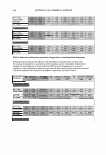374 JOURNAL OF COSMETIC SCIENCE INTRODUCTION The major methods to quantitatively assess wrinkles and fine wrinkles include macro scopic assessment and measurement of replicas using an instrument (1-3). In general, the macroscopic assessment method lacks objectivity due to differences in the criteria among observers. To solve this problem, the use of a photoscale with a confirmed statistical validity has been reported (4,5 ). In recent years, we obtained facial photos from Japanese females ranging in age from 10 to 80, and we developed a photoscale to assess wrinkles in eight areas of their faces (6). In that study we found that the wrinkle score in all areas of the face increased with age. We also developed a photoscale to measure sagging in the subzygomatic area, and we reported an age-related increase in the sagging score (7). On the other hand, Griffiths et al. (4) and Larnier et al. (5) developed a scoring system for photodamage using close-up facial photos as standard images, but they suggested that those standards cannot be used in Asians because of more marked influ ences of photoaging on pigmentation than on wrinkle formation compared with Cau casians (4,5). There have been no detailed studies comparing wrinkles in eight areas of the face (forehead, glabella, upper eyelid, corner of the eye, lower eyelid, nasolabial groove, cheek, and corner of the mouth) between Caucasians and Japanese using the same wrinkle score criteria. In addition, there have been no studies comparing sagging in the subzygomatic area according to the same criteria. Therefore, we have now compared wrinkles in those eight areas of the face, and we have measured morphological differences in the subzygomatic area in Caucasian females living in Cincinnati, Ohio, in the U.S. and in Japanese females living in Tokyo, using our previously developed photoscale, which was originally established by using photos of various grades of wrinkling and sagging in eight facial areas of Japanese female subjects (6,7). METHODS SUBJECTS AND PHOTOGRAPHIC METHODS Eighty-five healthy Caucasian females (ages 20-69) living in Cincinnati, Ohio, in the U.S. volunteered for this test, and adequate consideration was given to their human rights and safety. After washing their faces, they entered a room at a temperature of 22°C. After 20 minutes of acclimatization, they sat on chairs with their eyes open, and two photos of each subject (a frontal view and an oblique 45° view) were taken with a Fuji Film Sl digital camera. After a standard color sample was attached to each subject, all photographs were taken at a shutter speed of 1/125 sec, with an aperture stop of 22, and printing was adjusted to provide consistent color. Seventy Japanese females (ages 20-69) living in Tokyo and its environs also participated in this test, and adequate consideration was given to their human rights and safety. After washing their faces, they entered a room at a temperature of 20°C with 50% RH. After 15 minutes, they sat on chairs with their eyes open, and two photos (a frontal view and an oblique 45° view) were taken with a Nikon Dl digital camera. After a standard color sample was attached to each subject, all photographs were taken at a shutter speed of 1/250 sec, with an aperture stop of 29, and prints were similarly standardized. Table I shows the age distribution of the Caucasian and Japanese females in this study.
AGE-RELATED FACIAL WRINKLING Age group 20-29 31-39 41-49 51-59 61-69 Total WRINKLE SCORE ASSESSMENT Table I Distribution of the Subject Population Caucasian 16 21 17 15 16 85 Number in Group Japanese 14 14 14 14 14 70 375 The wrinkle score in eight areas of facial skin (forehead, glabella, upper eyelids, corner of the eye, lower eyelids, nasolabial groove, cheeks, and corner of the mouth) and sagging in the lower cheek area were measured according to photo standards as previously reported (6,7). These standards were originally established from photos of various grades of wrinkling and sagging in eight facial areas of Japanese female subjects and statistically proved useful by kappa coefficient analysis (8,9), respectively. Wrinkles were graded on a scale of 5: 1 = no wrinkles 2 = mild wrinkles 3 = mild/moderate wrinkles 4 = moderate wrinkles 5 = severe wrinkles. Sagging was graded on a scale of 6: 0 = no sagging (no irregularities on the cheek) 1 = slight sagging (the relief of the nasolabial groove was distinct due to the descent of the upper cheek area) 2 = mild sagging (the relief of the nasolabial groove was distinct due to the descent of the upper cheek area, and a shallow relief formed from the anterior area of the ear toward the jaw) 3 = moderate sagging (the relief of the nasolabial groove to the corner of the mouth was clear) 4 = severe sagging (the relief of the nasolabial groove was connected to the corner of the mouth and from the anterior area of the ear toward the jaw) 5 = very severe sagging ( the cheek dropped beyond the outline of the jaw, and a silk crepe-pattern relief appeared in the cheek). Score assessment was performed by an experienced observer. STATISTICAL ANALYSIS A linear function was used to calculate the correlation coefficients between the wrinkling or sagging scores and the ages of the subjects, as shown in the tables. Differences were analyzed by Mann-Whitney's U test. RESULTS COMPARISON OF WRINKLE SCORE IN CAUCASIAN FEMALES AND IN JAPANESE FEMALES Table II shows the wrinkle scores in eight areas of the face in the 85 Caucasian females using the photoscale established for Japanese females. In the group aged 20-29 years, the score was 2 (mild wrinkles) or more in all areas, except for the upper eyelid. The wrinkle scores in all areas increased with age. The group aged 60-69 years showed high mean
Purchased for the exclusive use of nofirst nolast (unknown) From: SCC Media Library & Resource Center (library.scconline.org)






































































































